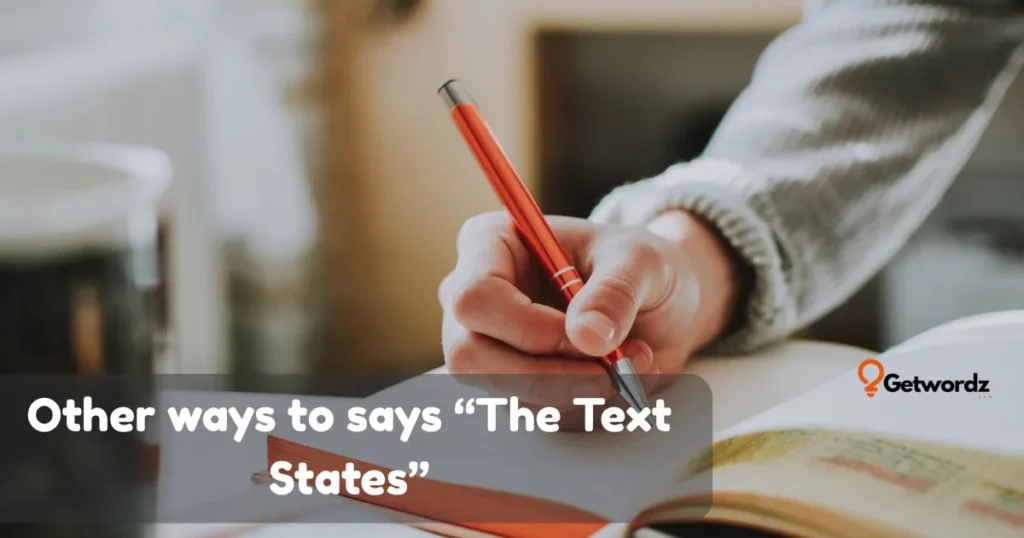“The text states” is one of those go-to phrases that shows up in essays, research papers, and professional reports everywhere. It’s a straightforward way to reference written information, but let’s be honest, it’s also overused, repetitive, and a little dry. That’s why so many people search for better, more natural ways to say the text when they want their writing to sound polished and engaging.
If you’ve ever struggled to make your analysis sound less robotic or wanted your message to flow more smoothly, you’re in the right place. This post explores fresh, creative, and context-appropriate alternatives to the text states, expressions that sound natural whether you’re writing an academic essay, explaining a quote to a colleague, or summarizing a message to a friend.
With the right phrasing, you can make your ideas sound more confident, professional, and authentic. Ready to discover some powerful alternatives to the text states that bring clarity and variety to your writing? Let’s dive in.
1. According to the Text
Scenario: You’re writing a literature essay or research paper and want to reference a passage without sounding repetitive.
Explanation: “According to the text” is a formal yet smooth alternative to the text states. It signals that the information comes directly from the source, making it perfect for academic writing, reports, or analyses.
Examples:
- According to the text, the author believes freedom is essential to identity.
- According to the text, climate change affects every continent differently.
- According to the text, teamwork plays a crucial role in success.
Why It Works: This phrase sounds polished, authoritative, and professional. It naturally integrates your reference into the sentence and strengthens your credibility as a writer.
2. The Passage Explains
Scenario: When summarizing a section from a novel or report, you want a phrase that smoothly introduces the idea.
Explanation: “The passage explains” is a creative alternative to the text states that implies clarification or elaboration. It fits well in literary essays and analytical discussions.
Examples:
- The passage explains how the main character overcomes adversity.
- The passage explains the significance of unity in the community.
- The passage explains why honesty is a recurring theme.
Why It Works: It adds clarity and flow to your writing, helping your analysis feel more connected and easy to follow.
3. As Mentioned in the Text
Scenario: You’re referring back to something that’s already been cited or discussed earlier.
Explanation: “As mentioned in the text” is a formal and respectful way to reference an author’s point. It works well in essays, research papers, and professional summaries.
Examples:
- As mentioned in the text, consistent practice leads to improvement.
- As mentioned in the text, communication is key in leadership.
- As mentioned in the text, small actions can create big change.
Why It Works: It shows attentiveness and comprehension, making your argument sound informed and connected to the source.
4. The Author Notes
Scenario: You want to highlight an author’s observation or insight in an analytical essay.
Explanation: “The author notes” feels formal but personal—it attributes the idea directly to the writer, not just the document.
Examples:
- The author notes that courage often emerges in moments of fear.
- The author notes how society shapes personal values.
- The author notes that technology redefines connection.
Why It Works: It’s concise and authoritative, making your academic tone sound confident and professional.
5. The Article Suggests
Scenario: When writing about a blog post, journal, or report that proposes an idea rather than states a fact.
Explanation: “The article suggests” is a thoughtful alternative that conveys interpretation instead of certainty, ideal for analytical writing.
Examples:
- The article suggests that early education improves future opportunities.
- The article suggests leadership can be learned over time.
- The article suggests that social media impacts mental health.
Why It Works: It communicates nuance and critical thinking—essential for essays and reports that value balanced perspectives.
6. The Evidence Shows
Scenario: You’re presenting proof from a text to support an argument.
Explanation: “The evidence shows” is a strong, factual phrase that adds credibility to your writing. It’s often used in research papers and analytical essays.
Examples:
- The evidence shows a clear link between effort and results.
- The evidence shows that cooperation improves outcomes.
- The evidence shows readers value authenticity.
Why It Works: It’s persuasive and grounded in logic—perfect for building arguments based on textual support.
7. As Described in the Passage
Scenario: You’re referring to how something was portrayed or detailed in a book or report.
Explanation: “As described in the passage” provides a formal, descriptive tone and fits academic and literary contexts.
Examples:
- As described in the passage, the town represents isolation.
- As described in the passage, the character’s growth mirrors change.
- As described in the passage, the experiment followed strict protocols.
Why It Works: It emphasizes comprehension and ties your analysis neatly back to the source.
8. The Source States
Scenario: You’re summarizing a scholarly article or citation.
Explanation: “The source states” is a professional substitute for the text states—ideal for citing studies, data, or research findings.
Examples:
- The source states that renewable energy is growing globally.
- The source states communication barriers affect performance.
- The source states that culture shapes behavior.
Why It Works: It’s concise, authoritative, and fits academic, professional, and journalistic contexts.
9. The Document Indicates
Scenario: You’re referencing an official record, report, or manuscript.
Explanation: “The document indicates” sounds formal and factual, perfect for legal, business, or technical writing.
Examples:
- The document indicates a rise in customer satisfaction.
- The document indicates compliance with new regulations.
- The document indicates consistent growth over time.
Why It Works: It adds professionalism and precision, showing your analysis is grounded in verified information.
10. The Reading Reveals
Scenario: You’re analyzing text for hidden meanings or deeper insights.
Explanation: “The reading reveals” implies discovery and understanding, making it ideal for literature or reflective essays.
Examples:
- The reading reveals the tension between freedom and control.
- The reading reveals an underlying theme of hope.
- The reading reveals how change is a constant element.
Why It Works: It sounds thoughtful and interpretive, adding emotional depth to your writing.
11. The Novel Illustrates
Scenario: You’re writing a book analysis and want to describe how a story presents a specific theme or situation.
Explanation: “The novel illustrates” is a powerful alternative to the text that adds creativity and depth. It highlights how the author uses narrative or characters to show ideas, making it great for literary essays.
Examples:
- The novel illustrates how love can overcome social barriers.
- The novel illustrates the conflict between personal freedom and duty.
- The novel illustrates the impact of loss on human growth.
Why It Works: This phrase invites readers to visualize concepts and demonstrates that you’re analyzing beyond surface-level meaning. It feels insightful and professional.
Read More: Other Ways to Say “It was a Pleasure working with You”
12. The Report Highlights
Scenario: You’re discussing findings or conclusions from an academic or professional document.
Explanation: “The report highlights” is a polished and formal phrase that emphasizes important points or discoveries. It’s a professional alternative to the text states suitable for workplace or research settings.
Examples:
- The report highlights key improvements in project performance.
- The report highlights the challenges of implementing new technology.
- The report highlights a growing interest in sustainable solutions.
Why It Works: It’s clear, direct, and adds authority to your summary, making your writing sound both credible and concise.
13. The Paragraph Discusses
Scenario: You’re analyzing a specific section of a reading or text for detail.
Explanation: “The paragraph discusses” is a simple, academic-style phrase that helps transition between ideas smoothly. It’s great for essays and analytical summaries.
Examples:
- The paragraph discusses the link between culture and identity.
- The paragraph discusses how leadership evolves through experience.
- The paragraph discusses potential solutions to the issue.
Why It Works: It helps organize your analysis and guide readers through complex discussions with ease.
14. The Research Shows
Scenario: You’re citing a study or scholarly article that provides evidence for your point.
Explanation: “The research shows” is a credible, factual alternative to the text states that signals verified information. It’s commonly used in academic or scientific writing.
Examples:
- The research shows a connection between nutrition and focus.
- The research shows students perform better with active learning.
- The research shows long-term benefits of consistent routines.
Why It Works: It enhances credibility and supports your statements with authority and precision.
15. The Excerpt Demonstrates
Scenario: You’re focusing on a specific part of a text to prove an analytical point.
Explanation: “The excerpt demonstrates” emphasizes how a section of writing supports a larger theme or idea. It’s a sophisticated and creative alternative.
Examples:
- The excerpt demonstrates the tension between tradition and change.
- The excerpt demonstrates how imagery enhances emotional impact.
- The excerpt demonstrates the author’s critical perspective on power.
Why It Works: It shows close reading skills and makes your interpretation sound sharp and intentional.
16. The Passage Shows
Scenario: You want to explain how a part of the text expresses a theme or argument.
Explanation: “The passage shows” is a simple yet expressive substitute for the text states. It’s great for both essays and classroom discussions.
Examples:
- The passage shows how kindness transforms the character’s journey.
- The passage shows that hope persists even in hardship.
- The passage shows the value of self-awareness.
Why It Works: It feels natural, easy to read, and helps readers quickly grasp the message without sounding repetitive.
17. The Study Reveals
Scenario: You’re summarizing research data or academic analysis.
Explanation: “The study reveals” is a professional and confident phrase that indicates discovery or insight. It’s ideal for reports, case studies, and data-driven writing.
Examples:
- The study reveals that positive habits boost productivity.
- The study reveals changing trends in digital communication.
- The study reveals a link between mindfulness and mental health.
Why It Works: It conveys authority and progress, keeping your tone confident and evidence-based.
18. As Outlined in the Text
Scenario: You’re referring to a structure, plan, or point already detailed in a document.
Explanation: “As outlined in the text” is formal and smooth, showing that you’re referencing established content directly.
Examples:
- As outlined in the text, the company’s mission focuses on integrity.
- As outlined in the text, education reform remains a priority.
- As outlined in the text, communication fosters collaboration.
Why It Works: It’s polished and specific, helping your writing sound informed and well-organized.
19. The Essay Argues
Scenario: You’re referencing another writer’s main point or stance.
Explanation: “The essay argues” conveys persuasion and reasoning, making it perfect for academic discussion or critical reviews.
Examples:
- The essay argues that success depends on self-discipline.
- The essay argues that freedom requires accountability.
- The essay argues for empathy as a form of strength.
Why It Works: It’s assertive yet formal, helping you summarize perspectives confidently and clearly.
20. The Text Emphasizes
Scenario: You want to show that a point in the writing is especially important.
Explanation: “The text emphasizes” is a clear, impactful alternative that highlights focus or repetition in a source.
Examples:
- The text emphasizes the importance of honesty in relationships.
- The text emphasizes the value of persistence in growth.
- The text emphasizes community as a foundation of success.
Why It Works: It shows you can identify central ideas, adding depth and focus to your interpretation.
21. The Passage Points Out
Scenario: You’re explaining a direct statement or claim from a section of text.
Explanation: “The passage points out” feels natural and conversational while still fitting academic tone.
Examples:
- The passage points out that leadership requires empathy.
- The passage points out the consequences of neglect.
- The passage points out how history often repeats itself.
Why It Works: It keeps your writing fluid and approachable without losing clarity or professionalism.
22. The Reading States
Scenario: You’re directly summarizing or referencing an assigned text or article.
Explanation: “The reading states” is a clean and straightforward version of the text states that works perfectly for educational writing.
Examples:
- The reading states that innovation thrives on collaboration.
- The reading states conflict builds stronger relationships.
- The reading states progress requires consistent effort.
Why It Works: It maintains academic formality while improving readability and tone.
23. The Author Writes
Scenario: You’re quoting or paraphrasing something the writer said directly.
Explanation: “The author writes” is a simple yet effective way to connect your discussion to the source material.
Examples:
- The author writes that time reveals true character.
- The author writes that dreams shape our destiny.
- The author writes that forgiveness brings peace.
Why It Works: It’s versatile and natural, making it useful in essays, summaries, and reflections alike.
24. The Section Explores
Scenario: You’re referring to a part of a document that dives into detail or analysis.
Explanation: “The section explores” adds a sense of curiosity and depth, ideal for analytical or reflective writing.
Examples:
- The section explores cultural influences on creativity.
- The section explores the balance between risk and reward.
- The section explores how technology impacts emotions.
Why It Works: It sounds active and thoughtful, guiding the reader to see the text as a dynamic exploration.
25. The Author Explains
Scenario: You’re referencing a writer’s explanation of an idea or theory.
Explanation: “The author explains” is a balanced phrase that conveys understanding and clarity.
Examples:
- The author explains the meaning behind the symbol of light.
- The author explains why justice matters in every society.
- The author explains the importance of truth in storytelling.
Why It Works: It blends professionalism with approachability, helping your analysis feel both grounded and clear.
Read More: Other Ways to Say “I Said Creatively” with Examples!
26. The Passage Demonstrates
Scenario: You’re analyzing a specific textual moment that supports a theme.
Explanation: “The passage demonstrates” highlights evidence effectively and feels more dynamic than the text states.
Examples:
- The passage demonstrates how love inspires resilience.
- The passage demonstrates the value of courage under pressure.
- The passage demonstrates how hope drives progress.
Why It Works: It’s powerful and vivid, encouraging engagement with both the text and your analysis.
27. The Material Suggests
Scenario: You’re interpreting text with multiple possible meanings.
Explanation: “The material suggests” conveys interpretation rather than certainty, making it ideal for analytical depth.
Examples:
- The material suggests conflict often leads to self-discovery.
- The material suggests balance is key to long-term happiness.
- The material suggests unity can overcome division.
Why It Works: It adds nuance and flexibility, showing readers that you’re thinking critically and creatively.
28. The Passage Indicates
Scenario: You want to point to a clear implication or message in the text.
Explanation: “The passage indicates” is professional and neutral, great for both academic and general use.
Examples:
- The passage indicates growing awareness of responsibility.
- The passage indicates how resilience defines character.
- The passage indicates a shift in the writer’s perspective.
Why It Works: It helps convey subtle meanings with confidence and precision.
29. The Writer Points Out
Scenario: You’re referring to something the writer directly identifies or clarifies.
Explanation: “The writer points out” is approachable and conversational while maintaining authority.
Examples:
- The writer points out how habits shape identity.
- The writer points out that patience leads to success.
- The writer points out the importance of reflection.
Why It Works: It keeps your tone friendly but credible, making academic writing feel more human.
30. The Author States
Scenario: You’re quoting or paraphrasing a key line or idea from a text.
Explanation: “The author states” is one of the most common yet dependable alternatives to the text states. It’s formal, clear, and effective.
Examples:
- The author states that persistence is the path to mastery.
- The author states that knowledge empowers change.
- The author states the theme centers on moral choice.
Why It Works: It’s direct, trustworthy, and easy for readers to understand, making it a timeless choice for academic or professional writing.
✅ Pros of Using The Text States
Pros
- 💡 Clarity and Simplicity: It clearly shows that the information comes directly from a written source making it easy for readers to follow
- 🎓 Academic Precision: This phrase is widely accepted in essays research papers and reports keeping your writing formal and credible
- 🔁 Consistency: It provides a neutral tone that fits most academic and professional contexts
- 📖 Direct Reference: It quickly connects your statement to a specific source reducing ambiguity
- 🌍 Universally Understood: Teachers students and professionals instantly recognize it which enhances comprehension
⚠️ Cons
- 😕 Overused and Repetitive: It’s one of the most common academic phrases often making your writing sound dull or formulaic
- 🧍 Lacks Personality: The phrase feels mechanical and doesn’t reflect personal voice or critical thinking
- 🚫 Limited Versatility: It doesn’t fit well in creative conversational or informal writing styles
- 🌀 Weak Flow: Repeating it too often can interrupt sentence rhythm and make your writing sound choppy
- 💤 Minimal Engagement: It informs but doesn’t engage which can make your analysis seem dry or uninspired
Closing words
Finding fresh alternatives to overused phrases like the text states can instantly make your writing sound more polished and engaging. This post explored creative expressions and better wording choices that help you avoid repetition while keeping your tone professional and authentic. Using different ways to say the text states allows you to express ideas more clearly and confidently.
Whether you’re writing an essay for class, drafting a research paper, or sharing insights with colleagues, these unique expressions fit every context. Try one of these creative alternatives in your next piece of writing and notice how much smoother and more natural your message feels.
By using thoughtful, varied language, you make your analysis more credible and your communication more impactful. Elevate your writing today with smarter ways to say the text states.




